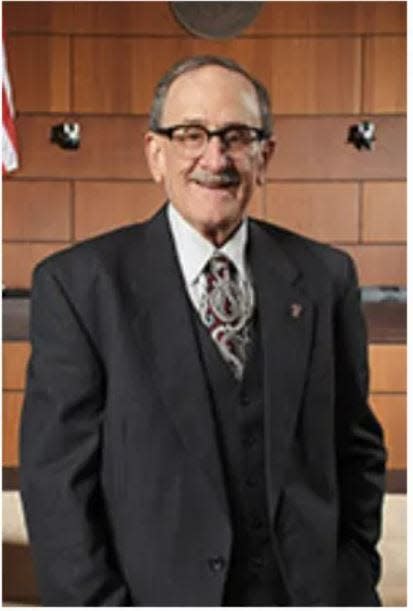It's Debatable: Exploring National Rifle Association v. Vullo
- Oops!Something went wrong.Please try again later.
In this week's "It's Debatable" segment, Rick Rosen and Charles Moster look at the court case National Rifle Association (NRA) v. Vullo and debate: Does the First Amendment permit adverse regulatory action against advocacy organizations because of their political views? Rosen retired as a professor from the Texas Tech University School of Law and is a retired U.S. Army colonel. Moster is founder of the Moster Law Firm based in Lubbock with seven offices including Austin, Dallas, and Houston.
Rosen - 1
Banks and insurance companies may refuse to provide financial services and coverage to the NRA because they disagree with its gun-rights advocacy. They are private actors not subject to the First Amendment. But if—as the Supreme Court held over 60 years ago—the government through “coercion, persuasion, or intimidation” deliberately sets out to prevent these private actors from providing services to suppress such advocacy, it violates the First Amendment. This is the central issue in NRA v. Vullo, a case currently before the Supreme Court.

New York’s Department of Financial Services (“DFS”) regulates and oversees all banks and insurance companies doing business in the state. The NRA alleged that because of their animus to gun-rights advocacy, DFS and former Governor Andrew Cuomo carried out a campaign to chill the political speech of the NRA by leveraging state power to punish financial institutions that maintain business arrangements with the NRA.
While serving as DFS’ Superintendent, Maria Vullo issued press releases, regulatory guidance, and investigations and penalties against insurance companies and financial institutions doing business with the NRA. At the same time, Vullo’s boss, then-Governor Cuomo, directed DFS “to urge insurers and bankers statewide to determine whether any relationship they may have with the NRA or similar organizations sends the wrong message to their clients and their communities.” Cuomo later stated: “The NRA is an extremist organization. I urge companies in New York State to revisit any ties they have to the NRA and consider their reputations, and responsibility to the public.” Because of “fear of regulatory hostility in New York,” NRA’s insurance companies revoked their coverage and banks withdrew bids for the NRA’s business.
The NRA sued both Cuomo and Vullo, and the district court sustained its First Amendment claim. Despite its obligation to accept as true all factual allegations of the NRA’s complaint, the court of appeals reversed the district court, finding that the NRA’s complaint did not plead the requisite coercive conduct to support its First Amendment claim.
The court of appeals’ decision is flatly incorrect. First, Supreme Court precedent does not require that a state use coercion to stifle free speech—allegations of “persuasion” or “intimidation” are sufficient. As an ACLU amicus brief stated: “If true, [the NRA’s] allegations represent a blatant violation of the First Amendment. [P]ublic officials … cannot abuse their regulatory authority to retaliate against disfavored advocacy organizations and to impose burdens on those organizations’ ability to conduct lawful business.”
Second, the insurance companies that withdrew NRA’s coverage did so because of the fear of adverse regulatory action. And according to the Financial and Business Law Scholars amicus brief: “The reality of banking and insurance regulation is that firms frequently feel that they risk sanction if they do not comply with nominally non-binding guidance.”
Consequently, the Supreme Court should reverse the court of appeal’s decision and allow the case to proceed, permitting the NRA to prove its allegations.
Moster - 1

This case should never have found its way to the Supreme Court. Rick picks up the NRA gauntlet framing the issue as central to upholding First Amendment freedoms, but as the State of NY succinctly stated, “The decision below did nothing of the sort.”
Contrary to the allegations of the NRA, Cuomo – the former Governor of NY and Superintendent Vullo, did not engage in any actions which constituted “coercion, persuasion, or intimidation”. The subject conduct related to the horrific mass shootings at a high school in Parkland, Florida on February 14, 2018, which resulted in the murder of 17 students. In his capacity as Governor, Cuomo grieved the loss and issued a press release that he had “directed the DFS (NY Dept. of Financial Services) to urge insurance companies, NY State charted banks, and other financial services companies licensed in NY to review any relationships they may have with the NRA and other similar organizations.”
In accordance with Mr. Cuomo’s sentiments, DFS issued two “guidance” memos entitled “Guidance on Risk Management Relating to the NRA and Similar Gun Promotion Organizations.” However, neither the Governor’s statements nor guidance memos directed any instrumentality of the state if NY to apply governmental pressure on the NRA or deprive these private entities the right to exercise constitutionally protected First Amendment rights.
This critical distinction is set forth in the brief filed by the State of NY before the Supreme Court, “Neither the guidance memoranda nor Respondent’s quote in Governor Cuomo’s press release ordered or directed any regulated entity to take any action. They did not invoke any law or regulation that any regulated entity risked violating if it did not sever ties with the Petitioner. They did not threaten that the DFS would take any action against any entity for severing those ties. And indeed, DFS took no such action”.
So, there you have it in a nutshell. The State of NY did absolutely nothing wrong and most definitely did not intimidate or coerce the NRA in any way. Accordingly, the appellate court was correct in dismissing the NRA’s frivolous claim.
Moreover, Rick fails to address the critical ruling of the appellate court which justified its decision to kick out the NRA’s lawsuit, i.e., the State of NY was shielded by the privilege of “qualified immunity” for issuing public statements in this case. Qualified immunity “gives government officials the breathing room to make reasonable, even if mistaken, judgments and protects ‘all but the plainly incompetent or those who knowingly violate the law’”. Malley v. Briggs 475 U.S. 335 (1986). Such is an independent basis for dismissing the NRA lawsuit which had nothing to do with alleged First Amendment violations.
The Supreme Court should never have agreed to review the proper and correct determination of the Second Circuit Court of Appeals to dismiss the NRA’s lawsuit. Such unwarranted review is once again “proof positive” that we have a “run away interventionist” court that seeks to perpetuate its agenda of securing “judge-made law”. That is NOT what our Founding Fathers intended.
That is precisely what is going on here notwithstanding the clever attempt to frame the issue as invoking First Amendment rights.
The Supreme Court must adhere to the rule of law and rule in favor of the State of NY.
Rosen - 2
Charles and the Second Circuit are incorrect. All the NRA needed to survive a motion to dismiss its complaint was to state sufficient facts allowing the court to draw a reasonable inference that the defendants are liable for the misconduct alleged. Importantly, the court must accept as true the factual allegations of NRA’s complaint and construe the allegations in the light most favorable to the NRA. The
NRA certainly pleaded sufficient factual allegations that Cuomo and Vullo wielded their powers to stifle NRA’s free speech.
First, Charles cannot deny that both Cuomo and Vullo made it clear in public statements that they wanted banks and insurance companies to cease doing business with the NRA, claiming that the NRA’s gun-rights advocacy created “reputational risks” by sending the “wrong message”—matters of concern to state regulators.
Second, the NRA alleged that the regulatory agency suggested to the regulated parties that they could reduce their exposure to fines and penalties if they stopped doing business with the NRA, and that Vullo made an example of regulated parties who did business with them by increasing the parties’ exposure to fines and penalties.
Third, the insurance companies and banks perceived the defendants’ actions as unambiguous pressure, coercion, and threats. Because of the defendants’ actions, banks and insurance companies dismantled their relationship with the NRA, fearing losing their New York licenses if they continued business as usual.
Charles asserts that the Supreme Court should have never taken the case; however, the Second Circuit’s decision conflicted with the 1953 Supreme Court’s ruling in Bantam Books v. Sullivan and with a 2015 decision of another court of appeals—quintessential grounds for granting Supreme Court review. He also states that the defendants are entitled to a qualified immunity from the lawsuit. Perhaps that may be true, but it is irrelevant at this stage of the litigation. Moreover, the test for qualified immunity is whether a public official violated clearly established law. In this case, the Supreme Court clearly established the law in Bantam Books; that is, government cannot use private parties to punish speech the government disfavors.
Finally, the fact the ALCU represents the NRA speaks volumes: while the NRA’s gun-rights position may be an anathema to the ACLU, it represents the NRA “because of the First Amendment issues at stake.” Specifically, Maria Vullo “threatened to use her regulatory power over banks and insurance companies to coerce them into denying basic financial services to the NRA …. Vullo’s threats were expressly based on her disagreement with the NRA’s advocacy. And they worked.”
Moster – 2
Rick starts out his argument by stating that “Charles and the Second Circuit are incorrect”.
First, I truly want to thank Rick for including me in such distinguished company. That aside, the NY Federal Appeals Court got it right in this case and the NRA claims should have been dismissed.
It was within the discretion of the court to conclude that the statements made did not rise to the level of constraining First Amendment Speech. Critically, as pointed out repeatedly in the brief filed by the State of NY, Cuomo and Vullo did not order the banks and insurance companies to do anything – and that is the critical issue.
Rick refers to a bevy of nebulous effects such as “reputational risks” which sent the “wrong message." Talk about an imprecise measure of damages. I would wager that most lawyers and, in particular, non-lawyers, would see this phrase for exactly what it is which is hogwash – to use a printable term. The Second Circuit had every right to see through this vacuous fact pattern and determine that there was a legal basis for dismissal.
Moreover, the Court properly determined that the doctrine of “qualified immunity” applied thus barring the NRA claims altogether. Rick partially concedes this point referring to my argument as follows: “He also states that the defendants are entitled to a qualified immunity from the lawsuit. Perhaps that may be true, but it is irrelevant at this stage of the litigation.”
I am afraid not. There is nothing irrelevant to a finding of qualified immunity as this would bar any action to be asserted against Cuomo and Vullo – and that’s precisely what the Second Circuit Court of Appeals concluded in dismissing this frivolous claim along with the facts underlying the alleged adverse effect on First Amendment rights.
Although I have taken issue with the Supreme Court on many issues in the column, this is not one of them. They got it right.
This article originally appeared on Lubbock Avalanche-Journal: It's Debatable: Exploring National Rifle Association v. Vullo
